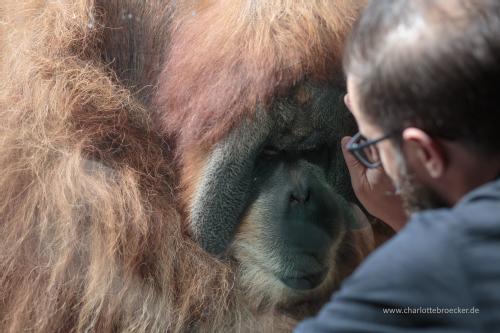The Communicative Mind

There are five species of great ape: humans (Homo sapiens), chimpanzees (Pan paniscus), bonobos (Pan troglodytes), gorillas (Gorilla) and orangutans (Pongo). Each species communicates using both gestures and vocalisations. However only humans acquire language. Why is this?
According to a standard view (Tomasello 2008) humans alone acquire language because we possess biological adaptations for Theory of Mind ('ToM') – the ability to think about others' mental states – that great apes lack. These enable us to act with and attribute the 'Gricean' (Grice 1957) communicative intentions that are necessary for natural language development. Since great apes lack ToM, they can neither attribute communicative intentions nor acquire language. Problematically for the standard view, though, the ToM thought necessary for Gricean communication seems to develop in children only as a result of language acquisition (e.g. Lohmann & Tomasello, 2003), and it emerges only several years after children start to use and understand language. If the mindreading needed for communication is itself language dependent, then it cannot contribute to an explanation of language acquisition. Since empirical data (Krupenye & Kano et al., 2016) also shows that the ToM of great apes is similar to that of pre-verbal infants, the standard view also leaves the absence of language in great apes unexplained.
To dissolve these explanatory puzzles, the Communicative Mind project will develop a new account of the relationship between ToM, language, and communication. From the starting assumption that both great apes and human infants can act with and attribute communicative intent (Moore 2017a), the project will set out to establish that key socio-cognitive differences between humans and non-human great apes are in substantial part culturally learned, not biologically inherited. These differences emerge because humans but not apes can use syntactically structured utterances to communicate, and because on the back of this ability, generations of language-users have developed linguistic tools for theorising about mental states. Thus, it is not ToM that explains the development of language, but syntax and the cultural evolution of language that explains the development of ToM. Children learn to use these tools in ontogeny, through cultural practices of conversation and storytelling, and thereby acquire new tools for thinking about minds.
Using ideas and methods drawn from Philosophy, Linguistics, and Developmental and Comparative Psychology, the Communicative Mind project will develop new accounts of the evolution of language in phylogeny, of the development of ToM in ontogeny, and of the similarities and differences between human and great ape minds. This will include accounts of the developmental relationship between syntax mastery and the ability to represent what others know; of the phylogenetic emergence in humans of a cognitive architecture that allows us, but not our great ape cousins, to use syntax; of the cultural evolution of the elements of syntax used for ToM talk in natural languages; and of the cultural variation in ToM talk. By showing that uniquely human cognitive traits emerge through language and communicative interaction, we will demonstrate the fundamentally social foundations of human thinking.
This project is supported by a UKRI Future Leaders Fellowship awarded to Richard Moore. The project started in February 2020 and will initially last for four years.
Recommended Background Reading
Apperly IA, Butterfill SA (2009) Do humans have two systems to track beliefs and belief-like states? Psychological Review, 116(4), 953-70.
Helming KA, Strickland B, Jacob P (2016) Solving the puzzle about early belief‐ascription. Mind & Language, 31(4), 438-69.
Evans N, Wilkins D (2000) In the mind's ear: The semantic extensions of perception verbs in Australian languages. Language, 546-92.
Grice HP (1957) Meaning. The Philosophical Review, 377-88.
Heyes CM, Frith CD (2014) The cultural evolution of mind reading. Science, 344(6190): 1243091.
Krupenye C, Kano F, Hirata S, Call J, Tomasello M (2016) Great apes anticipate that other individuals will act according to false beliefs. Science, 354(6308), 110-4.
Lillard A (1998) Ethnopsychologies: Cultural variations in theories of mind. Psychological Bulletin, 123(1), 3-32.
Lohmann H, Tomasello M. The role of language in the development of false belief understanding: A training study. Child Development, 74(4), 1130-44.
Moore R (2014) Ape gestures: Interpreting chimpanzee and bonobo minds. Current Biology, 24(14): R645-R647.
Moore R (2016) Meaning and ostension in great ape gestural communication. Animal Cognition, 19(1): 223-231.
Moore R (2017a) Gricean communication and cognitive development. Philosophical Quarterly, 67(267), 303-326.
Moore R (2017b) Convergent minds: ostension, inference and Grice’s third clause. Interface Focus, 7: 20160107.
Moore R (2017c) Social cognition, Stag Hunts, and the evolution of language. Biology and Philosophy. 32(6), 797–818.
Moore R (2018) Gricean communication, language development, and animal minds. Philosophy Compass, 13(12): e12550.
Moore R (Online first) The cultural evolution of mind-modelling. Synthese.
Rubio-Fernández P, Mollica F, Ali MO, Gibson E (2019) How do you know that? Automatic belief inferences in passing conversation. Cognition, 193: 104011.
Tomasello M (2008) Origins of Human Communication. MIT Press.
Online Lab Meeting
Fridays, 14:00-15:30. All are welcome; contact Richard Moore for details.
Project Members
Dr Richard MooreLink opens in a new window (UKRI Future Leaders Fellow)
Dr Katharina Helming Link opens in a new window(Post-Doctoral Research Fellow, Department of Psychology)
Dr Giulia PalazzoloLink opens in a new window (Post-Doctoral Researcher, Department of Philosophy)
Nawaal Kiwia (Research Assistant)
Anna Flynn (Work Placement Research Assistant, Aston University
Project Advisors
Professor Sotaro KitaLink opens in a new window (Department of Psychology, University of Warwick)
Dr Paula Rubio-FernandezLink opens in a new window (Senior Research Fellow, University of Oslo)
Professor Nick EvansLink opens in a new window (Director, ARC Centre of Excellence for the Dynamics of Language, Australian National University)
Collaborators
Dr Susana MonsóLink opens in a new window (Assistant Professor, Department of Philosophy, UNED)
Dr Leda BerioLink opens in a new window (Post-Doctoral Researcher, Department of Philosophy, Heinrich-Heine-Universität Düsseldorf)
Lialin Rotem-Stibbe (Berlin School of Mind and Brain)
